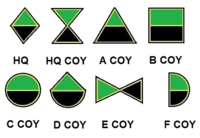Durban Regiment
| Durban Regiment | |
|---|---|

SANDF Durban Regiment emblem
|
|
| Active | 1 January 1960 to present |
| Country |
|
| Allegiance | |
| Branch | |
| Type | Infantry |
| Role | Mechanised infantry |
| Size | One Battalion |
| Part of |
South African Infantry Formation Army Conventional Reserve |
| Garrison/HQ | Lord's Grounds, Durban, Kwa-Zulu Natal 29°51′1.7454″S 31°1′22.08″E / 29.850484833°S 31.0228000°ECoordinates: 29°51′1.7454″S 31°1′22.08″E / 29.850484833°S 31.0228000°E |
| Motto(s) | Punga Celeriter (Strike swiftly) |
| Insignia | |
| Identification symbol |
Silver Fish Eagle on a Gold Sea Shell |
| Company level Insignia |  |
| SA Motorised Infantry beret bar circa 1992 | |
Durban Regiment is a motorised infantry Reserve Force unit of the South African Army. As a reserve unit, it has a status roughly equivalent to that of a British Army Reserve or United States Army National Guard unit.
Established in 1923 as the Durban Volunteer Guides, the unit was disbanded after World War Two but reformed on paper in 1959 as an armoured infantry unit.
Durban Regiment was officially proclaimed in 1959 and the first posting to the unit was on 1 January 1960 with Colonel M.B. Williams JCD with 30 Yr Clasp as its first officer commanding.
The Regiment’s first mobilisations were on 31 March 1960 to combat unrest in Natal’s Cato Manor area. They were, in fact, the first regiment mobilised and committed to this action.
First formed as an armoured infantry regiment, the Durban Regiment was later converted to motorised infantry.
On May 31, 1961 the unit was again mobilised for participation in the ceremonies accompanying the Declaration of the Republic of South Africa.
The Regiment proudly received its colours on 10 October 1964.
In 1969, Durban Regiment was instructed to transfer all Afrikaans speaking unit members to a newly formed unit, Regiment Port Natal (RPN).
As from the formal inauguration of the unit, authority was acquired for the formation of a military band that functioned to support the unit at military functions and parades. In 1976 the Montclair Pipe band (a civilian band) affiliated to the military band and over a very short time the pipe contingent absorbed the bugles and trumpets of the military band. The Durban Regiment Pipe Band now forms the musical component at the unit and effectively supports the unit at military functions and parades.
Annual training camps were completed every year until 1972 when Durban Regiment began duties on either the South West Africa (Namibia) or Mozambique borders during the South African Border War. In addition to the border duties, from 1982, Durban Regiment also became involved in counter insurgency operations in urban operations in urban areas, mainly in the Kwa-Zulu Natal area.
...
Wikipedia

